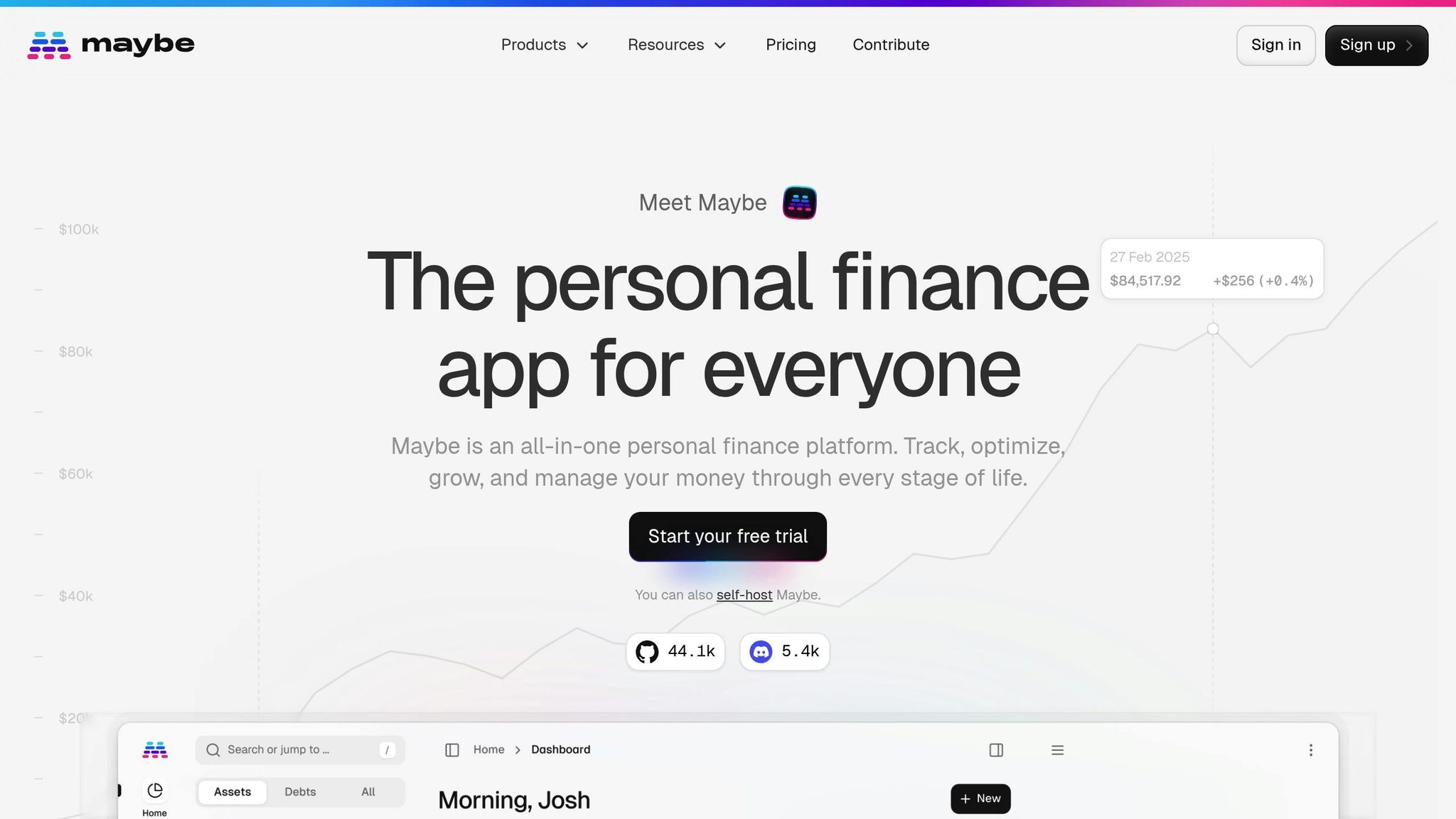How AI Personalizes Financial Goal Tracking

Josh Pigford
AI is transforming how people manage their finances by making goal tracking faster, easier, and more personalized. Here's what you need to know:
- Automated Insights: AI categorizes transactions with 92-97% accuracy, analyzes spending habits, and adjusts recommendations in real time.
- Stress-Free Budgeting: It calculates safe spending limits, predicts financial trends with 90% accuracy, and sends alerts for bills or overspending risks.
- Custom Goals: AI updates savings, debt repayment, and investment plans based on changes like income shifts or life events.
- Real-Time Tracking: Platforms like Maybe Finance provide dashboards with visual progress updates, spending analysis, and smart suggestions.
AI simplifies complex financial planning, helping users make better decisions and stay on track with their goals.
How AI Processes Financial Data
AI takes raw financial data and transforms it into insights that users can act on, all thanks to its advanced data processing capabilities. This process forms the backbone for accurate financial tracking and goal-setting.
Collecting and Sorting Financial Data
AI systems connect securely to more than 10,000 financial institutions via APIs, giving users real-time access to their transaction history and account balances. Using natural language processing, these systems categorize transactions with impressive precision by analyzing:
- Merchant names and descriptions
- Transaction amounts and timing
- Patterns in recurring payments
- Location-based details
What’s remarkable is how fast this happens - AI processes all this data in under two seconds, making real-time tracking a reality.
| Processing Feature | AI Performance | Conventional Methods |
|---|---|---|
| Categorization Accuracy | 92–97% | 85% |
| Processing Speed | <2 seconds | 5+ seconds |
| False Positive Rate | <0.5% | 2% |
Understanding User Financial Habits
After categorizing transactions, AI digs deeper into financial behaviors to create tailored recommendations. It evaluates several key indicators, including:
- Spending velocity: The rate at which users spend money after receiving income
- Cyclical patterns: Spending habits tied to weekly, monthly, or seasonal trends
- Payment timing: How bills are paid in relation to their due dates
- Category elasticity: How spending in specific areas changes with income fluctuations
For example, if the system detects habitual overspending on weekends, it can adjust daily spending limits to encourage better financial discipline while allowing more flexibility during the week. Using time-series analysis, AI also identifies trends and predicts future financial patterns. These predictive models are highly reliable, with error rates below 5% in 90% of cases. This forward-looking capability enables users to anticipate and prepare for upcoming financial needs.
Setting and Updating Goals with AI
AI has reshaped how we approach financial goal-setting by offering flexible, personalized targets that can adapt to changes in your life and financial situation. Here's a closer look at how AI keeps your goals relevant and aligned with your circumstances.
Automatic Goal Updates
Life is full of surprises, and AI steps in to ensure your financial goals stay on track, even when things change. Using anomaly detection, AI identifies shifts in your income or spending and recalibrates your goals automatically. For example, if your income increases, the system might boost your savings contributions or adjust your debt repayment plan.
Here’s how AI responds to various life changes:
| Life Change | AI Response | Goal Adjustment |
|---|---|---|
| Increased Income | Reassesses contributions | Updates savings and investments |
| Job Loss | Adjusts priorities | Recalibrates savings targets |
| Relocation | Conducts cost analysis | Accounts for local cost-of-living |
| Family Changes | Rebalances priorities | Shifts focus among financial goals |
Personal Risk Assessment
Understanding your risk tolerance is key to setting realistic financial goals, and AI excels at this. By analyzing your spending habits, emergency fund status, investment behavior, and cash reserves, AI creates a detailed picture of your financial personality.
Based on this analysis, AI tailors your goals to match your comfort level. If you’re more cautious, it might suggest safer, conservative targets. On the other hand, if you’re willing to take on more risk, the system could recommend growth-oriented strategies. Over time, as it gathers more data about your financial behavior, AI refines its recommendations, ensuring they stay accurate and aligned with your evolving preferences.
Maybe Finance AI Features

Maybe Finance takes financial planning to the next level by applying AI to analyze your spending habits, uncover patterns, and offer tailored insights. This approach transforms how you set and track financial goals, making the process more intuitive and effective.
Setting Up Goals in Maybe Finance
The platform blends AI technology with user input to create a simple yet powerful goal-setting experience:
Initial Setup
Start by linking your accounts. The AI dives into your financial details - like income, spending habits, and existing obligations - to build a comprehensive picture of your situation.Value Assessment
A quick questionnaire helps the AI understand your financial priorities. This ensures the goals it suggests align with what’s most important to you.Goal Customization
The platform offers tailored recommendations based on your data. Here's an example of how it works:Goal Type AI Analysis Personalization Emergency Fund Reviews monthly expenses Suggests a realistic savings target Debt Payoff Examines interest rates Creates an efficient repayment plan Investment Evaluates risk tolerance Proposes a balanced investment strategy Custom Goals Assesses spending capacity Recommends achievable timelines
Once your goals are set, the platform translates them into clear, easy-to-follow visual progress updates.
Progress Tracking Dashboard
The dashboard is designed to keep you informed and motivated as you work toward your financial goals. It offers real-time updates and actionable insights through several standout features:
Visual Progress Indicators
Track your progress at a glance. The system uses AI to project your pace and adjusts these visuals dynamically as your financial situation evolves.Smart Monitoring System
This feature includes:- Multi-currency support for managing finances across borders
- A historical net worth tracker to monitor long-term growth
- Category-specific insights paired with AI-driven suggestions for improvement
Machine learning algorithms constantly evaluate your financial data. If the system spots potential challenges or opportunities, it sends smart alerts with personalized advice to help you stay on course.
The dashboard also includes scenario modeling tools. These allow you to simulate different financial strategies and see their potential outcomes before making decisions, giving you the confidence to adjust your goals as needed.
Advantages of AI Goal Tracking
AI-powered financial goal tracking brings a fresh approach to managing your money, making it faster, smarter, and more efficient than traditional methods. By using advanced data analysis and automation, AI reshapes how we set and achieve financial goals.
Cutting Down on Manual Effort
One of the biggest perks of AI is how much time it saves by reducing tedious tasks. With AI, those hours spent crunching numbers and entering data manually are a thing of the past:
- Transaction Categorization: Forget manually sorting through your expenses - AI automatically organizes your transactions, saving you the hassle.
- Data Synchronization: Real-time updates across all your accounts ensure you always have an accurate and up-to-date view of your finances.
Not only does this streamline your financial management, but it also keeps you one step ahead with intelligent alerts that help you avoid unexpected surprises.
Personalized Alerts and Recommendations
AI doesn’t just track your finances - it learns from them. By analyzing your financial habits, it delivers timely, tailored alerts and advice to help you stay on top of your goals.
Predictive Alerts
- Get reminders for upcoming bills based on your payment history.
- Receive warnings about potential overdrafts by analyzing your spending trends.
Behavioral Insights
- Spot and cancel unused subscriptions that drain your budget.
- Recognize patterns of overspending, such as during specific times or in certain categories.
- Highlight areas where you’re exceeding your budget.
Dynamic Recommendations
- Adjusts suggestions based on your progress and current cash flow. For instance, if you’re falling behind on a savings goal, the system might recommend cutting back in specific areas, trying alternative saving strategies, or setting up automated savings to keep you on track.
These AI-driven features don’t just simplify goal tracking - they make it smarter and more adaptable to your unique financial situation. With built-in security and transparency, AI tools are paving the way for even more advanced financial planning solutions.
Conclusion: AI Tools for Better Financial Planning
AI-powered financial tools are reshaping how we manage money. With their advanced ability to process and analyze data, these tools turn complex financial information into clear, actionable steps, helping users stay aligned with their financial goals.
Take Maybe Finance, for example. This platform showcases how AI can simplify personal finance. It consolidates all your financial information in one place and uses smart transaction categorization along with automated rules to make data management effortless. The result? A clearer understanding of your spending habits and better decision-making.
AI doesn’t just stop there - it evolves with your unique financial behavior. Whether you’re juggling investments, managing accounts in different currencies, or saving for a specific goal, AI tools can offer:
- Tailored Insights: Recommendations based on your spending habits and objectives
- Proactive Alerts: Early warnings about potential budget concerns
- Streamlined Organization: Automatic sorting and tagging of transactions
- Real-Time Adjustments: Updates to your goals as your financial situation changes
This level of customization helps create meaningful, long-term improvements in your financial health.
As tools like Maybe Finance continue to grow, they arm you with smarter, automated solutions to make more informed financial choices.
FAQs
How does AI protect my financial data when connecting to banks and other institutions?
AI plays a crucial role in protecting your financial data by using strong encryption methods and following strict privacy regulations. When interacting with financial institutions, AI ensures that your sensitive details are securely encrypted both during transmission and while stored, minimizing the chances of unauthorized access.
Platforms like Maybe Finance take it a step further by adhering to privacy laws like GDPR and similar regulations, guaranteeing that your personal and financial data is managed responsibly. Paired with ongoing monitoring and regular updates, these practices work together to keep your financial information as secure as possible.
What challenges might arise when using AI to track financial goals?
AI has opened up exciting possibilities for tracking financial goals, but there are a few hurdles to keep in mind. One of the biggest factors is data accuracy. AI tools are only as good as the information you feed them. If the data you provide is incomplete or incorrect, the insights you get might miss the mark. Setting up these tools often requires a bit of effort, too - like configuring preferences and linking accounts - to ensure the AI gets a full picture of your financial situation.
Another key concern is privacy and security. Since these systems often need access to sensitive financial details, choosing a platform with strong encryption and privacy safeguards is critical. For example, platforms like Maybe Finance tackle this head-on by offering self-hosting options. This gives users complete control over their data, creating a safer and more transparent experience.
Finally, it’s worth noting that AI-generated recommendations should never replace your personal judgment. While these insights can be incredibly helpful, it’s essential to weigh them against your own financial goals and circumstances before making any decisions.
How does AI adjust its recommendations if my financial situation changes suddenly, like losing a job or facing a large unexpected expense?
AI tools are built to adjust in real-time to shifts in your financial situation by analyzing new data and recalibrating their recommendations. For instance, if you face a job loss or an unexpected major expense, the system can reevaluate your income, spending habits, and savings targets to offer advice that fits your updated circumstances.
By consistently tracking your linked accounts and transaction history, AI can spot patterns, recommend budget tweaks, and help you focus on critical financial priorities. This way, even in tough times, you can stay on top of your finances and make choices that support your long-term financial well-being.

Subscribe to get the latest updates right in your inbox!